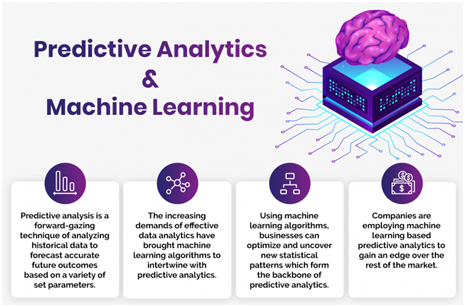
The word predictive is to guess or to anticipate upcoming events in the future. Predictive analytics is the use of data analysis, statistical modeling, and machine learning technology to ‘predict’ likely outcomes. It encompasses a wide variety of statistical techniques and technologies. The two most common types of predictive analytics models are classification models. They help predict outcomes such as when a component will fail. The regression models which help to predict a number, such as the average time before a breakdown. Predictive analytics increasingly used by various organizations in many sectors, such as manufacturing, retail, financial services, etc. AI-powered analytics platform with comprehensive predictive analytics capabilities. It delivers a scalable analytics and data visualization platform that enables businesses to design, deploy, and manage secure, interactive web applications, reports, and dashboards fed by multiple data sources.

The solution provides users with a 360-degree view of their business, explores billions of records in seconds and predictive analytics techniques all in a drag-and-drop experience, with no multiplex data modeling or coding required.
The Process Involved in Predictive Analytics
1. Project Definition: The first step is to identify the outcome of the project, the deliverables, business objectives, and based on which the data collection will be poised.
2. Data Collection: The next step is to collect data from multiple sources, To have a picture of the various customer interactions as a single view item.
3. Analysis: Further, the data is inspected, cleansed, transformed, and modeled to discover if it provides useful information and helps to conclude.
4. Statistics: This enables to validate if the findings, assumptions, and hypothesis are admirable to go ahead and test them using a statistical model.
5. Modeling: It helps in creating an error-free predictive model about the future that provides options to choose the best option that can be sorted through multi-model evaluation.
6. Deployment: Predictive model deployment provides an option to create and deploy the analytics results into productive decision-making. It also helps to generate results, reports, and other metrics.
7. Monitoring: Models that are prepared are further tracked to control and check for performance conformance to ensure that the desired results are acquired as expected.

Applications of Predictive Analytics
1. CRM: Predictive analytics helps to achieve various objectives. Marketing campaigns, sales, and customer services, Etc. Predictive analytics can be used in analytical customer relationship management. Throughout the customer life cycle right from the acquisition, relationship growth, retention. Customer win-back can be better planned and strategically addressed for retaining customers and labeling them more clearly.
2. Health care: Usage of predictive analytics can help to prevent cases and risks of those developing certain health-related complications like asthma, cancer, and other life-threatening ailments.
3. Collection Analytics: These applications optimize the allocation of collection resources by identifying collection agencies, contact strategies to reach out to them, legal actions to increase recovery, and cost reduction of collection.
4. Fraud Detection: Predictive Analytics can aid in the following. Spot inaccurate credit applications, deviant transactions leading to frauds both online and offline. Identity thefts and false insurance claim to save financial and insurance institutions of lots of security issues and damages to their operations.
5. Risk Management: Predictive analysis helps to maximize returns on the capital invested, probabilistic risk assessment so it could yield accurate forecasts are some of the key benefits of using predictive analytics.




